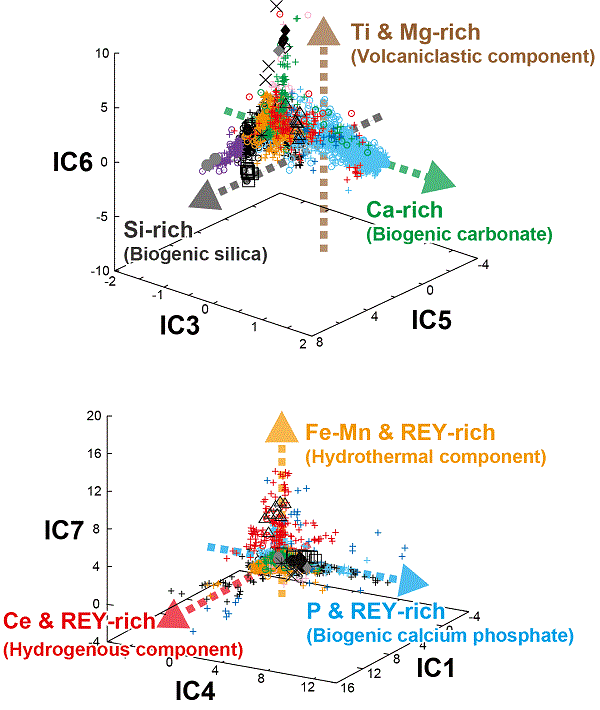Circumstances leading to formation of rare earth resources on the sea floor New mathematical statistics method reveals requisite conditions


Statistically independent components forming deep-sea muds
The result of Independent Component Analysis has shown that chemical compositions of bulk sediment samples consisting of 11 elements, including rare earth elements, from the Pacific and Indian oceans can be expressed by seven independent components including biogenic carbonate, biogenic silica, volcanic component, hydrothermal component, hydrogenous component, and biogenic calcium phosphate. Although cerium is a rare earth element, it is not classified as such in the present research because its geochemical behavior differs from that of other rare earth elements. Therefore, the notation “REY” (for “rare earth element and yttrium”) in the figure denotes total REY, excluding cerium.
© 2016 Kazutaka Yasukawa.
A research group at the University of Tokyo has demonstrated that sufficiently slow build-up of deposits on the sea floor is necessary for mineral resources rich in rare earth elements and yttrium (REY) to form. The researchers used statistical analysis to pore through huge amounts of data on the chemical composition of deep-sea sediment to make their findings. Experts anticipate that exploration of ocean deposits containing high concentrations of rare earth elements will develop in the future. The REY-rich mud is believed to be present near the sea floor surface meeting the above criteria, and the knowledge gained from the current study holds promise of helping to narrow down areas of the vast ocean for future resource exploration.
In 2011, a research group from the University of Tokyo discovered the widespread distribution of REY-rich mud, showing a high concentration of rare earths that are indispensable to the high-tech industry, in the deep-sea floor of the Pacific Ocean; but the factors contributing to the sediment becoming enriched with rare earth elements remained unclear.
The research group of Assistant Professor Kazutaka Yasukawa and Professor Yasuhiro Kato (who was part of the earlier research) of the Graduate School of Engineering at the University of Tokyo, and their collaborators collected data on the chemical composition of 3,968 deep-sea sediment samples from 101 sites spanning the Pacific and Indian oceans. The researchers determined by applying a statistical method called Independent Component Analysis that three components—one derived from hot water gushing out from the sea floor, another formed through slow deposition of metals from seawater, and a third composed of calcium phosphate originating from biological sources such as the teeth and bones of marine vertebrates—were closely involved in the accumulation of the rare earth elements. They also found that a key underlying factor for REY-rich mud to form is the presence of an environment with a sufficiently low sedimentation rate of less than 0.5 meters per 1 million years. Moreover, this study for the first time succeeded in visually rendering variations in the influence of geochemical components over space and time during the past 65 million years. The distribution patterns demonstrated that changes in the supply of dust carried by the wind, caused by the movement and drying of the Australian continent, influenced the accumulation of REY-rich mud in the South Pacific Ocean. This finding points to an important link between the generation of mineral resources on the deep-sea floor, and environmental changes and continental drift over the geologic time scale spanning several tens of millions of years.
“Until now REY-rich mud had been defined solely by their concentrations of rare earth elements, but our research has for the first time demonstrated that rare earth enrichment in the depths of the ocean can be characterized by three different, statistically independent components,” says Kato. He continues, “This research presents a new theoretical approach, ahead of others, of highly efficient resource exploration based on data-driven science, and is also important in providing novel approaches to the fields of resource engineering and earth sciences.”
Paper
, "Tracking the spatiotemporal variations of statistically independent components involving enrichment of rare-earth elements in deep-sea sediments", Scientific Reports Online Edition: 2016/07/22 (Japan time), doi: 10.1038/srep29603.
Article link (Publication)
Links
Graduate School of Engineering
Department of Systems Innovation, Graduate School of Engineering
Kato & Nakamura Laboratory, Department of Systems Innovation, Graduate School of Engineering (Japanese)
Frontier Research Center for Energy and Resources, Graduate School of Engineering
Japan Agency for Marine-Earth Science and Technology (JAMSTEC)






